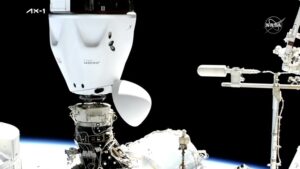Ax-1 undocks from space station after extended stay
Monday, 25 April 2022 00:58
A Crew Dragon undocked from the International Space Station April 24 carrying four private astronauts who spent nearly twice as long on the station as originally planned.
The post Ax-1 undocks from space station after extended stay appeared first on SpaceNews.
Crew of first private flight to ISS prepare for Earth return
Sunday, 24 April 2022 17:12
The crew of the first fully private mission to the International Space Station was set on Sunday to leave the orbiting laboratory and head back to Earth.
The three businessmen and a former NASA astronaut had spent more than two weeks on the station on a history-making mission organized by startup company Axiom Space.
A SpaceX capsule was scheduled to undock from the ISS at 8:55 pm (0055 GMT Monday) for the return trip, before landing in the ocean off the coast of Florida on Monday around 1:00 pm (1700 GMT).
The four men—three who paid tens of millions of dollars each for the rare chance to take part in the mission, and former astronaut Michael Lopez-Alegria, who holds dual US-Spanish citizenship—were originally scheduled to spend only eight days on the space station.
But bad weather on Earth forced repeated delays in their return.
Private passengers Larry Connor, an American who heads a real estate company, Canadian businessman Mark Pathy and Israeli former fighter pilot and entrepreneur Eytan Stibbe had blasted off from Florida on April 8, reaching the ISS a day later.
China to conduct asteroid deflection test around 2025
Sunday, 24 April 2022 11:07
China will aim to change the trajectory of a potentially threatening asteroid with a kinetic impactor test as part of plans for a planetary defense system.
The post China to conduct asteroid deflection test around 2025 appeared first on SpaceNews.
Today's space domain awareness just got better as new AFRL Space Lab opens
Sunday, 24 April 2022 08:44 The Air Force Research Laboratory Space Vehicles Directorate held a ribbon cutting ceremony April 11 to open a new facility named Skywave Technology Laboratory. The 3,500 square foot, $3.5 million lab is located in a remote area on Kirtland Air Force Base.
Though small in square footage compared to many AFRL labs, in acreage it is one of the largest. The Skywave Lab is situated on 72 acres
The Air Force Research Laboratory Space Vehicles Directorate held a ribbon cutting ceremony April 11 to open a new facility named Skywave Technology Laboratory. The 3,500 square foot, $3.5 million lab is located in a remote area on Kirtland Air Force Base.
Though small in square footage compared to many AFRL labs, in acreage it is one of the largest. The Skywave Lab is situated on 72 acres Roscosmos plans to soon start deliveries of ICBM Sarmat to Russian forces
Sunday, 24 April 2022 08:44 Russian state-owned space agency Roscosmos is planning to start serial shipments of the intercontinental ballistic missile (ICBM) Sarmat to the Russian strategic missile forces this fall, Roscosmos chief Dmitry Rogozin said on Wednesday.
"This fall, once the Sarmat flight and development tests are completed, we plan to begin supplying serial heavy intercontinental ballistic missiles of thi
Russian state-owned space agency Roscosmos is planning to start serial shipments of the intercontinental ballistic missile (ICBM) Sarmat to the Russian strategic missile forces this fall, Roscosmos chief Dmitry Rogozin said on Wednesday.
"This fall, once the Sarmat flight and development tests are completed, we plan to begin supplying serial heavy intercontinental ballistic missiles of thi Flexible quantum sieve filters out the deuterium
Sunday, 24 April 2022 08:44 Starship Enterprise flew through the galaxy using deuterium as fuel. Even if this was science fiction from the 1960s and 70s, research on the real application of the hydrogen isotope for energy generation is still going on today. The main challenge here is the extraction of the isotope. Deuterium (chem. abbrev. D, "heavy" hydrogen) is one of the three natural isotopes of hydrogen, along with pro
Starship Enterprise flew through the galaxy using deuterium as fuel. Even if this was science fiction from the 1960s and 70s, research on the real application of the hydrogen isotope for energy generation is still going on today. The main challenge here is the extraction of the isotope. Deuterium (chem. abbrev. D, "heavy" hydrogen) is one of the three natural isotopes of hydrogen, along with pro Search for life on Jupiter moon Europa bolstered by new study
Sunday, 24 April 2022 08:44 Scientists say they are one step closer to understanding Europa, a moon orbiting Jupiter that's widely considered the prime candidate for alien life forms within the solar system.
Europa is believed to contain subterranean salty water hidden by a thick outer shell of ice. But according to a new study examining the moon's topology, a certain topographical feature called a "double ridge"
Scientists say they are one step closer to understanding Europa, a moon orbiting Jupiter that's widely considered the prime candidate for alien life forms within the solar system.
Europa is believed to contain subterranean salty water hidden by a thick outer shell of ice. But according to a new study examining the moon's topology, a certain topographical feature called a "double ridge" Experts issue call to regulate space debris as levels of junk mount
Sunday, 24 April 2022 06:20 Proliferating levels of debris are posing a threat to the space environment and should be regulated as more satellites are being launched into space, researchers say.
Edinburgh University researchers said in a study published Friday in the journal Nature Astronomy the debris is troublesome, potentially affecting "professional astronomy, public stargazing and the cultural importance of t
Proliferating levels of debris are posing a threat to the space environment and should be regulated as more satellites are being launched into space, researchers say.
Edinburgh University researchers said in a study published Friday in the journal Nature Astronomy the debris is troublesome, potentially affecting "professional astronomy, public stargazing and the cultural importance of t NASA space technology programs face “constraining” budget
Saturday, 23 April 2022 23:31
A flat budget for NASA’s space technology programs is “very constraining” for the agency as it faces tough decisions about what efforts it can fund and at what amounts.
The post NASA space technology programs face “constraining” budget appeared first on SpaceNews.
Space startups argue for more agile business models
Saturday, 23 April 2022 18:36
Companies pursuing emerging technologies are getting funding from venture investors but also are looking for U.S. government support
The post Space startups argue for more agile business models appeared first on SpaceNews.
Iridium and General Dynamics submit joint bid for Space Development Agency contract
Saturday, 23 April 2022 09:04
Communications satellite operator Iridum and General Dynamics Mission Systems submitted a joint bid to operate and manage the Space Development Agency’s low Earth orbit constellation.
Beaming solar power from satellite array is Earth Day focus for AFRL
Saturday, 23 April 2022 07:01 In honor of Earth Day, the Air Force Research Laboratory, or AFRL, is highlighting its efforts toward harnessing the Sun's energy, converting it to radio frequency, or RF, and beaming it to the Earth providing a green power source for the U.S. and allied forces.
Key technologies need to be developed to make such a challenging process a reality.
In response to this challenge, AFRL for
In honor of Earth Day, the Air Force Research Laboratory, or AFRL, is highlighting its efforts toward harnessing the Sun's energy, converting it to radio frequency, or RF, and beaming it to the Earth providing a green power source for the U.S. and allied forces.
Key technologies need to be developed to make such a challenging process a reality.
In response to this challenge, AFRL for A roadmap for deepening understanding of a puzzling universal process
Saturday, 23 April 2022 07:01 A puzzling process called magnetic reconnection triggers explosive phenomena throughout the universe, creating solar flares and space storms that can take down mobile phone service and electrical power grids. Now scientists at the U.S. Department of Energy's (DOE) Princeton Plasma Physics Laboratory (PPPL) have detailed a roadmap for untangling a key aspect of this puzzle that could deepen insig
A puzzling process called magnetic reconnection triggers explosive phenomena throughout the universe, creating solar flares and space storms that can take down mobile phone service and electrical power grids. Now scientists at the U.S. Department of Energy's (DOE) Princeton Plasma Physics Laboratory (PPPL) have detailed a roadmap for untangling a key aspect of this puzzle that could deepen insig Lucy is "Go" for solar array deployment attempt
Saturday, 23 April 2022 07:01 On April 18, NASA decided to move forward with plans to complete the deployment of the Lucy spacecraft's stalled, unlatched solar array. The spacecraft is powered by two large arrays of solar cells that were designed to unfold and latch into place after launch. One of the fan-like arrays opened as planned, but the other stopped just short of completing this operation.
Through a combination
On April 18, NASA decided to move forward with plans to complete the deployment of the Lucy spacecraft's stalled, unlatched solar array. The spacecraft is powered by two large arrays of solar cells that were designed to unfold and latch into place after launch. One of the fan-like arrays opened as planned, but the other stopped just short of completing this operation.
Through a combination NASA, partners develop 'lunar backpack' technology to aid moon explorers
Saturday, 23 April 2022 07:01 Imagine a mountaineering expedition in a wholly uncharted environment, where the hikers had the ability to generate a real-time 3D map of the terrain. NASA researchers and their industry partners have developed a remote-sensing mapping system set to aid explorers in the most isolated wilderness imaginable: the airless wastes at the South Pole of the Moon.
The Kinematic Navigation and Carto
Imagine a mountaineering expedition in a wholly uncharted environment, where the hikers had the ability to generate a real-time 3D map of the terrain. NASA researchers and their industry partners have developed a remote-sensing mapping system set to aid explorers in the most isolated wilderness imaginable: the airless wastes at the South Pole of the Moon.
The Kinematic Navigation and Carto 
